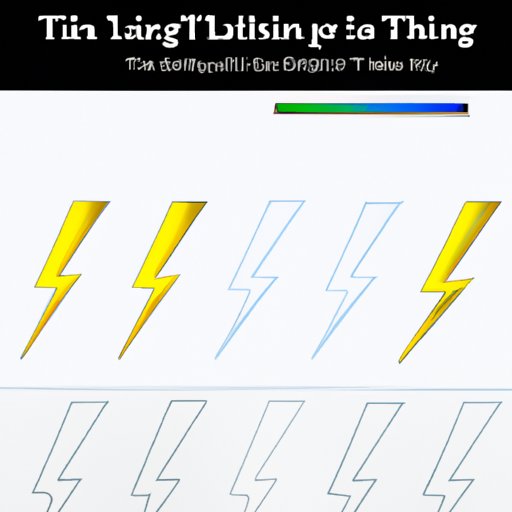
I. Introduction
Drawing lightning can be a challenging and thrilling experience for any artist. Capturing the raw energy and beauty of this natural phenomenon requires both technical skill and creative expression. However, many beginners may feel intimidated by the complexity and unpredictability of lightning. That’s why this article aims to provide a comprehensive guide on how to draw lightning, from basic tips and techniques to advanced tutorials and styles.
II. A beginner’s guide to drawing lightning: Tips and Techniques
Before delving into the specifics of drawing lightning, it’s essential to understand the basics of its structure, movement, and visual impact. Lightning usually takes the form of a jagged, branching line, which can vary in thickness, direction, and intensity. A lightning bolt is often associated with a loud thunderclap and a bright flash of light, which can reflect different colors and textures depending on the environment and time of day.
To create a convincing lightning drawing, it’s important to choose the right materials and tools. Graphite pencils, erasers, and blending stumps are essential for sketching, shading, and blending lightning. It’s also recommended to use a sturdy and smooth paper that can withstand erasing and smudging.
One of the key challenges of drawing lightning is to strike a balance between precision and expression. While lightning can be complex and unpredictable, it also offers a lot of room for creative interpretation. Therefore, it’s important to approach lightning drawing with curiosity, experimentation, and confidence. Start by practicing basic shapes and movements, and then add your own unique style and flair.
III. From pencil to paper: How to bring lightning to life through sketching
Sketching is the foundation of any good lightning drawing, as it helps to establish the composition, shape, and texture of the lightning. Here are some steps to follow:
- Start by making quick, rough sketches of the lightning, using basic shapes and lines to outline the general direction and movement.
- Gradually refine the sketch, using varying line weights and textures to create a more dynamic and realistic lightning bolt. Pay attention to details such as the branching patterns, the thickness of the lines, and the highlights and shadows.
- Use references such as photographs, videos, or real-life observations to guide the sketching process, but also feel free to deviate from them and add your own artistic touch.
- Experiment with different styles and approaches to lightning drawing, such as realistic, stylized, or abstract. Each style can offer unique and visually striking results depending on the context and intention of the drawing.
IV. Mastering the Art of Lightning: Step-by-Step Drawing Tutorial
For those who want a more structured and detailed approach to lightning drawing, here is a step-by-step tutorial:
- Start with a light sketch of the basic shape of the lightning. Use quick strokes to capture the general direction and branching pattern of the bolt.
- Gradually add more definition and texture to the lightning, using shading and blending techniques to create a sense of depth and movement. For example, use darker shades to define the edges and lighter shades to highlight the center.
- Pay attention to the details such as the intensity and thickness of the lightning, as well as the environment and context in which it appears. For example, a lightning bolt in a stormy sky might have a bluish hue, while a lightning bolt in a desert landscape might have a yellowish or orange hue.
- Adjust and refine the drawing as needed, using tools such as erasers, blending stumps, and sharpeners to achieve the desired effect.
V. Creating Thunder in your Art: Drawing Lightning for Impactful Results
Lightning can be a powerful and impactful element in any artwork, whether it’s a landscape, portrait, or sci-fi illustration. Here are some tips for using lightning to create dramatic and visually striking effects:
- Experiment with different compositions and angles of the lightning, such as a close-up view of a lightning bolt or a panoramic view of a stormy sky.
- Use color and contrast to enhance the impact of the lightning, such as contrasting a bright lightning bolt against a dark background or creating a complementary color scheme between the lightning and the environment.
- Borrow inspiration from other artists who have mastered the art of lightning, such as John Constable’s romantic landscapes or Hayao Miyazaki’s anime films.
- Remember to balance the lightning with the other elements of the artwork, such as the characters, landscape, or theme. The lightning should enhance the overall atmosphere and mood of the artwork, rather than overwhelm it.
VI. Electrify Your Art: Drawing Realistic Lightning Bolts with Colored Pencils
For those who want to take their lightning drawing to the next level, colored pencils offer a vibrant and versatile medium for creating realistic and dynamic lightning bolts. Here are some steps to follow:
- Start with a light sketch of the basic shape of the lightning, using a graphite pencil or a light-colored pencil.
- Gradually layer darker colors and hues onto the lightning, using blending techniques such as circular strokes or cross-hatching to create a sense of depth and texture.
- Add highlights and reflections to the lightning, using a white or light-colored pencil to create a sense of brightness and intensity.
- Adjust and refine the drawing as needed, using erasers, blending stumps, or other tools to achieve the desired effect.
VII. Conclusion
Drawing lightning can be both challenging and rewarding for any artist, regardless of their skill level or style. By following the tips and techniques outlined in this article, you can create stunning and dynamic lightning drawings that captivate the viewer and convey both the raw power and beauty of this natural phenomenon.
If you want to learn more about lightning drawing, there are many resources available online and offline, such as books, tutorials, or artist websites.




